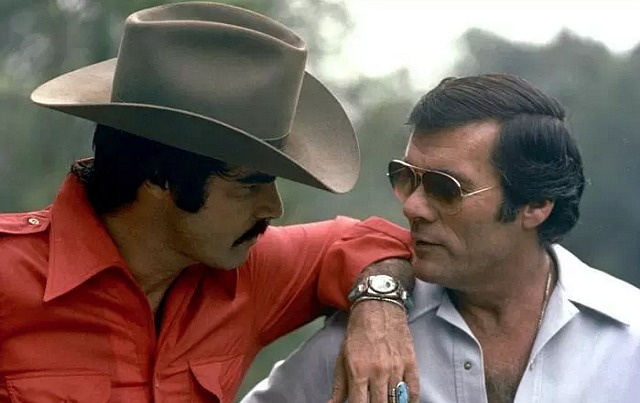In yesterday’s Paths of Glory thread (“And Today’s Verdict Is…?“), LexG claimed that my recent assertion about Quentin Tarantino‘s Once Upon A Time in Hollywood being based on the 1969 situations of Burt Reynolds and redneck movie director Hal Needham is a “Wells loony tune” riff. LexG allegedly knows this town pretty well, and yet he says “where did this gem come from?”
I’ll tell him where it came from — (a) common knowledge and (b) Reynolds and Needham‘s Wiki pages.
Tarantino will probably tap-dance or shilly-shally when some junket journalist asks him this point blank, but it all fits together. It’s right there on the page. The 1969 career situations of DiCaprio’s “Rick Dalton” (struggling, pushing-40 TV actor) and Pitt’s “Cliff Booth” (Dalton’s same-aged stuntman-buddy who shares his home) mirror Reynolds-Needham. Fucking obvious. Okay, with a little Clint Eastwood thrown in.

Cliff Booth, Rick Dalton in Once Upon A Time in Hollywood.

Burt Reynolds, Hal Needham during filming of Smokey and the Bandit.
In ’69 Reynolds, who had been acting on TV since the late ’50s (when he was in his early 20s), was a steadily working but diminished “known quantity” who was more or less poking along with B-level features like Sam Whiskey and 100 Rifles and short-lived TV series like Hawk and Dan August.
Reynolds had been trying and trying but was unable, during the first year of the Nixon administration when he was 33 years old, to break through into the bucks-up realm of A-level features.
And then, after 15 years in the business (when he was 20 or 21 he was told he couldn’t play a supporting role in Sayonara because he looked too much like Marlon Brando), Reynolds finally made it over the hump and became BURT REYNOLDS.
He accomplished this with the one-two-three punch of (a) his breakthrough lead role (studly survivalist Lewis with the bow-and-arrow) in John Boorman‘s Deliverance (’72), (b) that Cosmopolitan centerfold and (c) becoming a talk-show star with his amusing, self-deprecating patter in chats with Johnny Carson, Merv Griffin and David Frost.
In the space of a few months Reynolds was no longer Mr. Semi-Obscuro but suddenly the cool guy whom everyone liked and admired.
Reynolds Wiki excerpt: “Deliverance director John Boorman cast Reynolds on the basis of a talk-show appearance. ‘It’s the first time I haven’t had a script with Paul Newman‘s and Robert Redford‘s fingerprints all over it,’ Reynolds joked. ‘The producers actually came to me first.’
“‘I’ve waited 15 years to do a really good movie,’ Reynolds said in 1972. ‘I made so many bad pictures. I was never able to turn anyone down. The greatest curse in Hollywood is to be a well-known unknown.'”
Does Tarantino’s back-story for Dalton mirror Reynolds’ saga down to the last detail? Of course not (Tarantino has never been a scrupulous historical realist) but the basic template is obvious.
In the film Booth is Dalton’s best buddy and stunt double, and he and Dalton share a home — a stone’s throw from Sharon Tate and Roman Polanski‘s Benedict Canyon French farmhouse at 10050 Cielo Drive.
Needham Wiki excerpt: “Needham doubled regularly for Clint Walker and Burt Reynolds. [He] lived in Reynolds’ guesthouse for the better part of 12 years.”
So that’s the end of that discussion, but again, what an irony that Reynolds’ close friendship with Needham, whose star rose right along with Reynolds in the early ’70s, led to career deflation if not ruination. Reynolds had it all for 10 or 12 years, but he made too many fast-car yokel movies and this, combined with his ubiquituous talk-show presence, killed the allure.
The defining moment came when Reynolds passed on Jack Nicholson‘s astronaut role in Terms of Endearment in order to star in Needham’s Stroker Ace…brilliant!
By the mid ’80s BURT REYNOLDS had downshifted into Burt Reynolds, and he never really recovered. The hot period (’72 to ’84) was over. Reynolds even managed to blow his Paul Thomas Anderson Boogie Nights comeback…genius.

